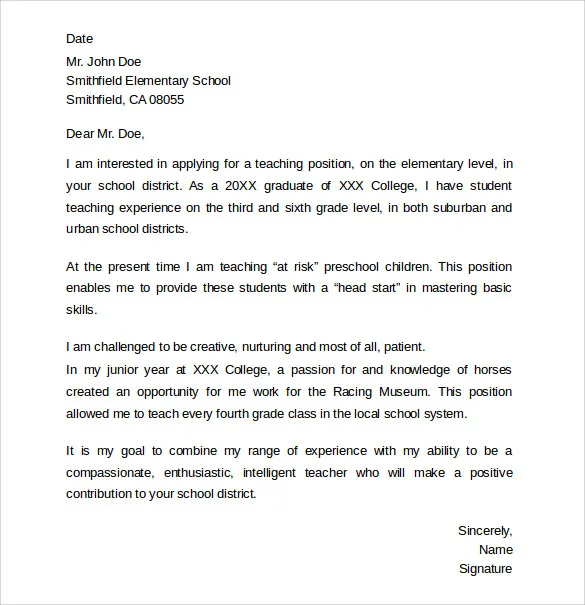Understanding Education Cover Letters
An education cover letter is a crucial document in your job application arsenal. It serves as your introduction to a potential employer, providing an opportunity to showcase your qualifications, skills, and passion for education. Unlike a resume, which presents a factual overview of your experience, a cover letter allows you to tell a story, explaining why you’re the perfect fit for the role and the institution. It’s your chance to make a strong first impression and persuade the hiring manager to delve deeper into your qualifications. A well-crafted cover letter can significantly increase your chances of landing an interview, making it an essential component of any job application in the field of education.
Why Education Cover Letters Matter
Education cover letters are important for several reasons. They allow you to personalize your application, demonstrating your genuine interest in the specific position and school. This is particularly important in education, where passion and dedication are highly valued. A cover letter allows you to connect your skills and experiences to the requirements of the job description, highlighting how you can contribute to the school’s mission and student success. It also gives you an opportunity to address any gaps in your resume or explain career transitions. Furthermore, a well-written cover letter showcases your communication skills, a critical attribute for educators. Ultimately, it’s your chance to set yourself apart from other applicants and make a compelling case for why you deserve an interview.
Key Components of a Strong Education Cover Letter
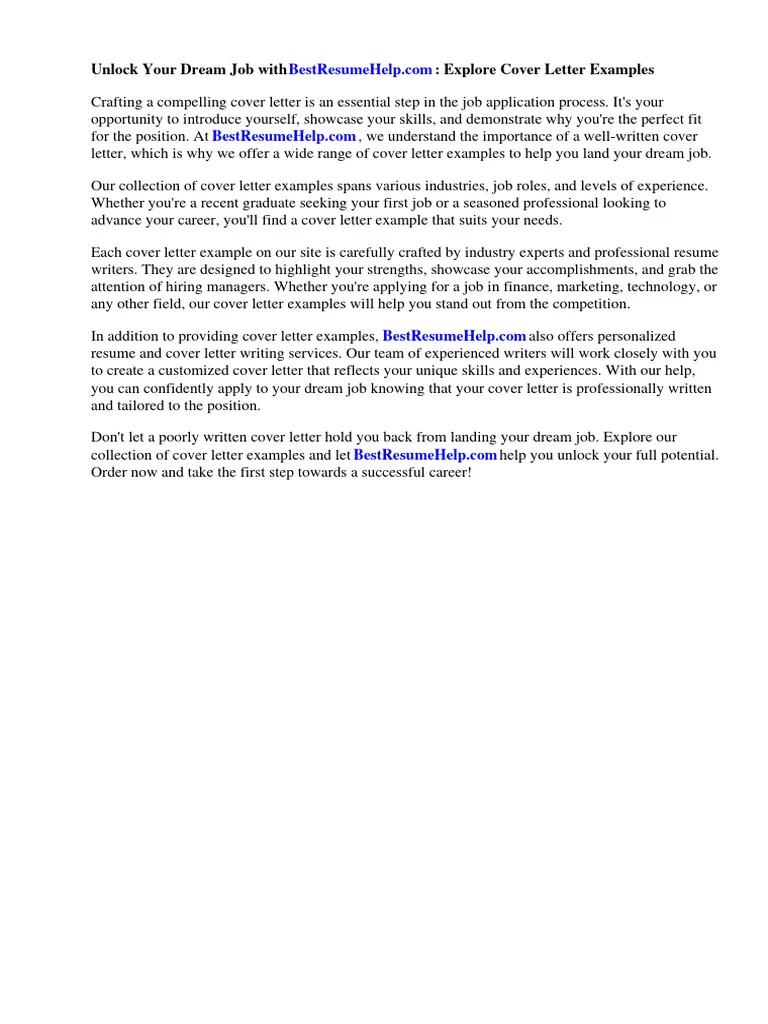
A strong education cover letter consists of several key components that, when combined, create a persuasive and compelling narrative. These elements work together to present a comprehensive picture of your qualifications and demonstrate your suitability for the role. Each section serves a specific purpose, from introducing yourself and expressing your interest to showcasing your skills and passion. By meticulously crafting each part of the cover letter, you can ensure it effectively communicates your value to the prospective employer.
Header and Contact Information
The header of your education cover letter should include your contact information, ensuring the hiring manager can easily reach you. This section should be clearly formatted and easy to read. Accuracy is paramount here; a misspelled email address or incorrect phone number could mean missing out on an opportunity. Proper formatting also contributes to a professional appearance, setting the tone for the rest of your letter. Your contact information should be consistent with what is on your resume, creating a cohesive and professional application package. A well-organized header demonstrates attention to detail, a valuable trait for educators.
Applicant’s Information
At the very top, include your full name, address, phone number, and professional email address. Use a clear and professional email address. Avoid nicknames or unprofessional email handles.
Recipient’s Information
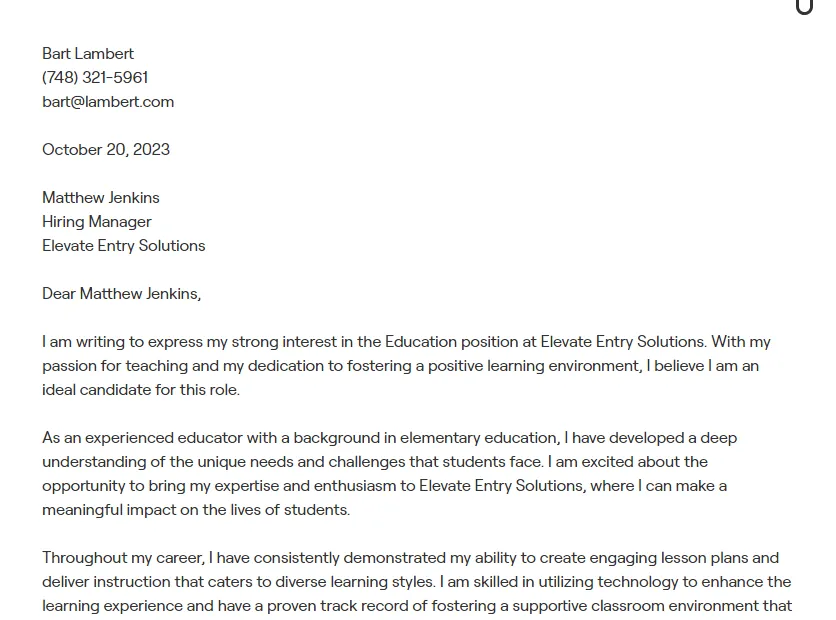
Beneath your information, include the hiring manager’s name, title, and the school or district’s address. If you don’t know the hiring manager’s name, research it or use a general title like “Hiring Committee”. Addressing your letter to a specific person shows that you’ve taken the time to personalize your application.
Professional Greeting
Begin your letter with a professional greeting. If you know the hiring manager’s name, use “Dear Mr./Ms./Dr. [Last Name]”. If you don’t know the name, consider using “Dear Hiring Committee” or “Dear [School Name] Hiring Team”. Avoid generic greetings like “To Whom It May Concern” as they can make your application feel impersonal. Your greeting sets the tone for the entire letter, so make sure it’s respectful and reflects the professionalism you intend to convey.
Crafting the Body of Your Education Cover Letter
The body of your education cover letter is where you make your case. This section should be well-structured, engaging, and focused on the specific requirements of the role and the school’s needs. It’s where you showcase your relevant skills, experiences, and achievements, demonstrating how you can contribute to student success and the school’s overall mission. Each paragraph should have a clear purpose, building a cohesive narrative that highlights your qualifications and passion for education. It is very important to keep a good tone and flow during the body, as this will keep the reader engaged.
Highlighting Relevant Skills and Experience
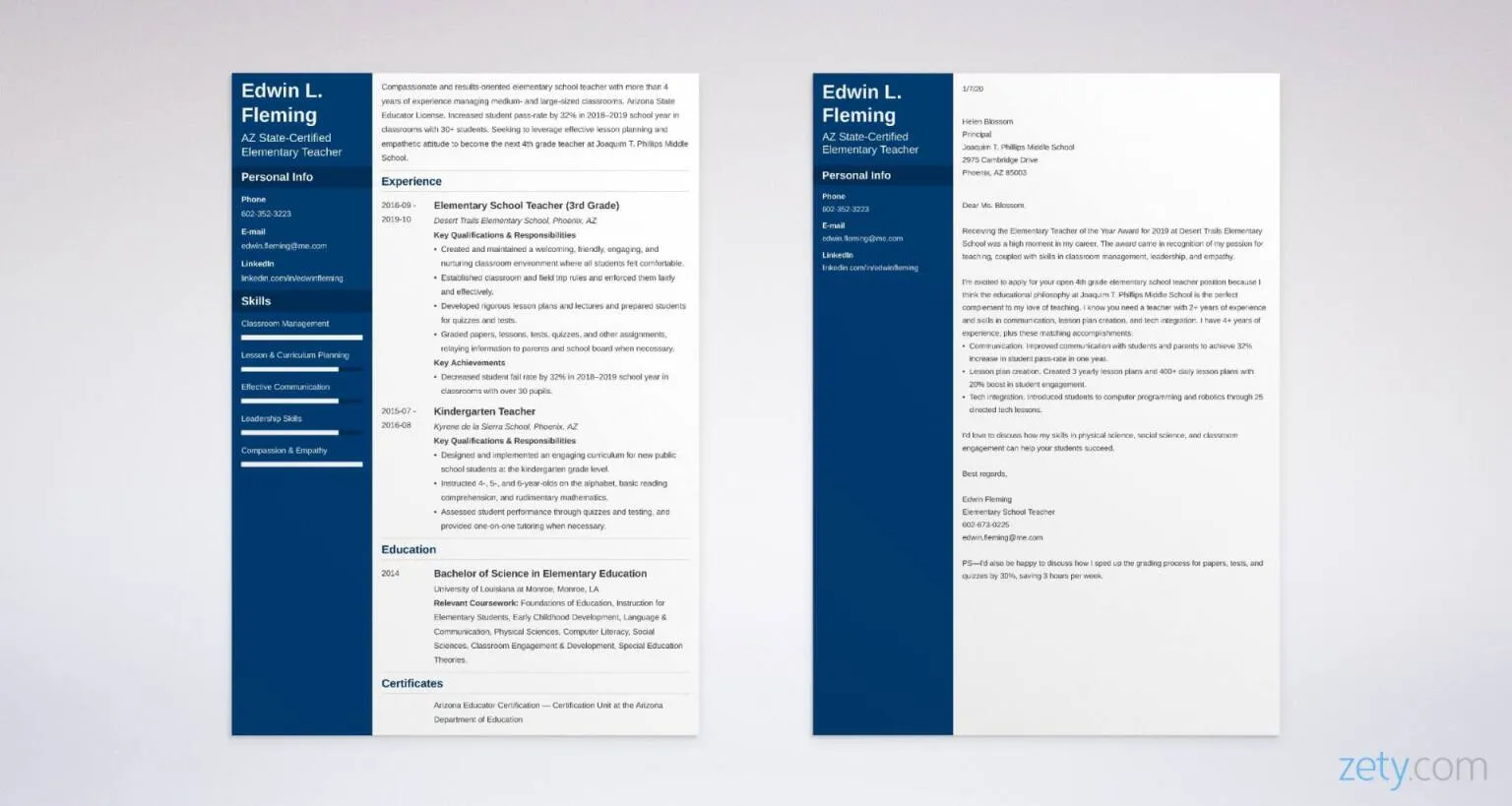
Carefully review the job description and identify the key skills and experiences the employer is seeking. Then, in your cover letter, provide specific examples of how you’ve demonstrated those skills in past roles or experiences. This could include classroom management, curriculum development, lesson planning, student assessment, or experience with specific educational technologies. Use action verbs to describe your accomplishments and quantify your achievements whenever possible. Avoid simply listing your skills; instead, show how you’ve applied them to achieve positive results. This helps the reader understand the value you bring to the table and it will catch their eye.
Tailoring Your Letter to the Specific Role
Avoid sending generic cover letters. Instead, tailor each letter to the specific role and school. Research the school’s mission, values, and programs to understand what they’re looking for in a candidate. Then, adjust your cover letter to reflect how your skills and experiences align with their specific needs. Highlight any relevant experience with their specific student demographics or educational philosophies. This level of personalization demonstrates your genuine interest in the position and your commitment to contributing to the school’s unique environment.
Quantifying Achievements and Impact
Whenever possible, quantify your achievements to demonstrate your impact. Instead of saying you “improved student test scores,” state the percentage increase. Instead of saying you “implemented new teaching strategies,” describe how those strategies led to specific improvements in student engagement or learning outcomes. Using numbers and data provides concrete evidence of your effectiveness and helps the hiring manager understand the value you can bring to the role. Providing specifics makes your claims much more credible and persuasive. This is how you can make your cover letter stand out from the competition.
Demonstrating Passion for Education
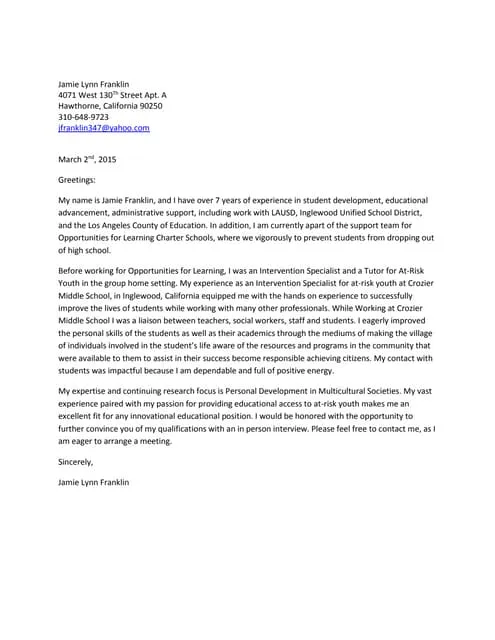
Education is a field driven by passion. In your cover letter, convey your enthusiasm for teaching, learning, and working with students. Describe what motivates you to be an educator, why you chose this profession, and what you find most rewarding about it. Talk about your commitment to creating a positive and engaging learning environment, your belief in the potential of every student, and your desire to make a difference. Your passion will not only make your cover letter more engaging but also demonstrate your dedication to the profession. Be sure to share your thoughts on the field and what motivates you.
Writing a Compelling Closing
The closing of your cover letter is your final opportunity to leave a lasting impression. It should be concise, professional, and reiterate your interest in the position. It’s where you express your gratitude for the reader’s time and consideration, and it’s where you outline your next steps. A strong closing will make the reader want to contact you and invite you for an interview.
Expressing Gratitude and Next Steps
Thank the hiring manager for considering your application. Reiterate your interest in the position and express your enthusiasm for the opportunity to contribute to the school. Then, state your availability for an interview and provide your contact information again. You can also mention any materials you are sending separately, such as a portfolio or writing samples. A clear and professional closing leaves a positive final impression and encourages the hiring manager to take the next step.
Proofreading and Formatting
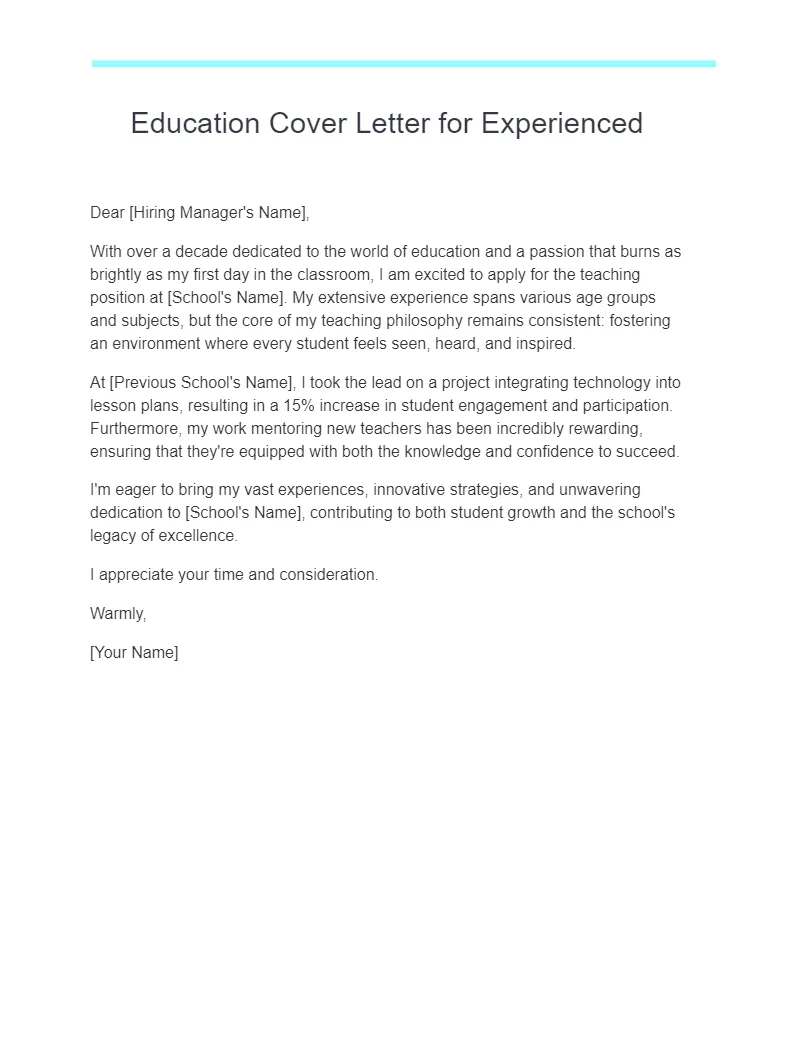
Before submitting your cover letter, carefully proofread it for any errors in grammar, spelling, and punctuation. These errors can undermine your credibility and make you appear unprofessional. Also, ensure your cover letter is well-formatted, with clear headings, paragraphs, and consistent spacing. Use a standard, easy-to-read font and maintain a professional tone throughout the letter. Consider having a friend or career counselor review your cover letter to provide feedback and catch any mistakes you may have missed. Proper proofreading is critical to ensuring that your hard work pays off.
Common Mistakes to Avoid
Even the most qualified candidates can hurt their chances by making common mistakes in their cover letters. Avoiding these pitfalls will significantly increase your chances of success. These are simple things to avoid, but many people make the same errors. Here are some of the most frequent issues and how to correct them.
Generic Language and Lack of Personalization
One of the most significant mistakes is using generic language and failing to personalize your cover letter. Avoid using phrases that could apply to any job or any school. Instead, tailor your letter to the specific role and school, demonstrating your understanding of their needs and values. Show that you’ve done your research and that you’re genuinely interested in the position. Address the hiring manager directly, and highlight the aspects of the job that excite you the most.
Typos and Grammatical Errors
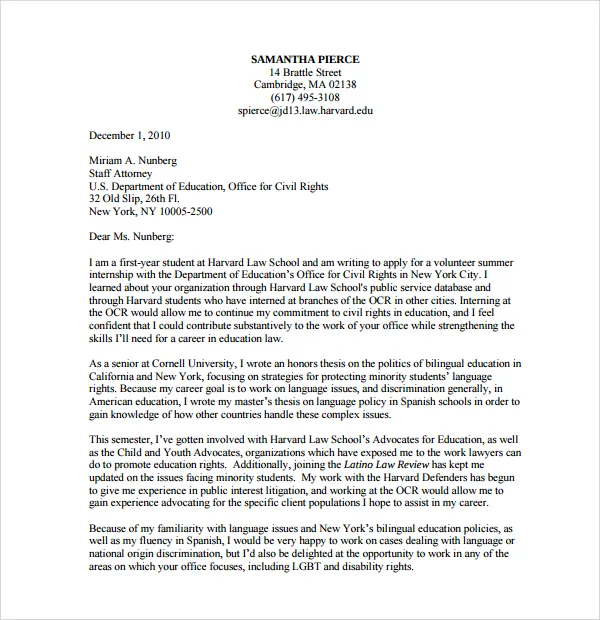
Typos and grammatical errors can be detrimental to your application. They show a lack of attention to detail and can make you appear unprofessional. Before submitting your cover letter, carefully proofread it for any errors. Use spell-check and grammar-check tools, but also read through the letter yourself to catch any mistakes those tools might miss. Having a friend or career counselor review your letter can also help you identify and correct any errors. A polished cover letter demonstrates your professionalism and respect for the hiring process.
Submitting Your Education Cover Letter
Once you’ve written and refined your education cover letter, it’s time to submit it. The way you submit your cover letter is also important; here’s how to ensure your application is complete and professional.
File Format and Naming Conventions
Always submit your cover letter in a professional file format, such as PDF, unless the application instructions specify otherwise. PDFs ensure that your formatting remains consistent regardless of the recipient’s software. Use a clear and descriptive file name, such as “YourName_CoverLetter_JobTitle”. This will help the hiring manager easily identify your application. Make sure your file name is straightforward and informative.
Follow-up Strategies

After submitting your cover letter and resume, it’s acceptable to follow up with the hiring manager. However, avoid being overly persistent. If you haven’t heard back within the timeframe specified in the job posting, or within two weeks, you can send a brief, polite email expressing your continued interest in the position. Reiterate your qualifications and thank the hiring manager for their time and consideration. This demonstrates your enthusiasm and professionalism without being intrusive. A simple follow-up can also help you confirm that your application was received.
